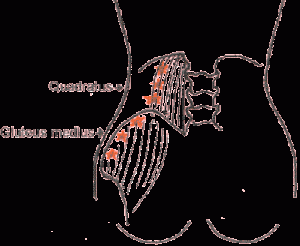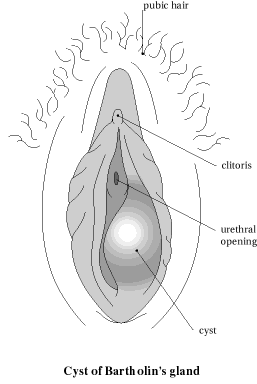Is an acute pelvic pain and small leakage of urine or stool affecting your life? You are likely to be suffering from Pelvic Floor Dysfunction (PFD), a condition that you should know all about – including its causes, symptoms, diagnosis and treatment.
Pelvic floor dysfunction Definition
Page Contents
It is a condition where the muscles of the pelvic floor become very loose, or tight, causing a host of other problems within the pelvis. Pelvic floor describes a network of ligaments, muscles and other tissues that protect the organs inside the pelvis including bladder, rectum, vagina and prostate. In this condition these tissues may become affected to a great or small extent, causing acute discomfort in the pelvic region.
Pelvic floor dysfunction Incidence
This is not exactly a gender-specific condition, although a larger percentage of the affected population consists of women. Men and children may also develop this pelvic disorder. 70% of patients with interstitial Cystitis have pelvic floor dysfunction, which is popularly known as Prostatodynia in men.
Pelvic floor dysfunction Symptoms
Some of the common symptoms of this condition, observed in both men and women, are:
Picture 1 – Pelvic floor dysfunction
Fecal incontinence
It is the inability to control the regular bowel movements, causing accidental leakage of stool or feces from the rectum. Patients may even feel that they cannot have a complete bowel movement at one time. They always have a tendency to have several bowel movements within a short span of time. In some cases, affected individuals may lose complete bowel control.
Urinary incontinence
Patients may also suffer from involuntary leakage of urine due to loss of bladder control. These frequent episodes of urine leakage may even occur while sneezing, laughing or lifting a heavy object. There is recurrent urgency to urinate despite low urine output or none. Intense pain during urination can often be quite distressing.
Pelvic organ prolapse
It is a common symptom in women where the pelvic organs such as uterus, urinary bladder or small bowel may fall down or slip out of place (prolapse). Such organs generally protrude through the vagina or the rectum, putting extensive pressure on the lower abdomen.
Sexual dysfunction
Some patients may experience difficulty and pain during an intercourse or sexual stimulation.
Defecatory dysfunction
It is an abdominal condition that develops into chronic constipation when there is a prolapse of the rectum. This makes it difficult to empty the bowels completely.
Chronic pelvic pain
There may be persistent pain in the pelvic region, the area below the bellybutton and between the hips. This is a common symptom in women that might last longer than six months.
Vulvodynia
Chronic pain may develop around the vulva, the opening of the vagina, without any definite cause. Patients may experience burning sensation and find it bothersome to sit at one place for longer duration.
Pelvic floor dysfunction Causes
It is generally not a gender specific disorder, and can affect both men and women. Major causes of this dysfunctioning of the pelvis are normally gender-specific. However, there are certain causes that are common to both the genders.
Causes of PFD in Men
In men, Non-bacterial Prostatitis is generally only one cause for this particular pelvic condition. It is a chronic disorder that causes long-term pain due to inflammation of the prostate gland or other sections of the lower urinary tract or genital area.
Causes of PFD in Women
Some of the possible causes in women, especially in new mothers, are:
Vaginal delivery
Pelvic floor muscles may get weakened in some women after delivery that specifically takes place through the vagina. This is the most common cause of urinary incontinence.
Menopause
During this phase, production of estrogen may decrease in many women, causing erosion and loosening of the pelvic floor muscles and connective tissues. This in turn increases susceptibility of these muscles to decreased elasticity and suppleness.
Pelvic inflammatory disease
It is an inflammation of the reproductive organs such as uterus, fallopian tubes, ovaries or cervix, owing to some form of sexually transmitted disease (STD). Bands of scar or fibrous tissue may develop in these organs, causing acute pelvic pain.
General Causes of PFD
Some of the common general causes are:
Obesity
Excess accumulation of body fat may have an adverse effect on the functioning of the pelvic floor muscles. Increased body weight causes heaviness and builds up intense pressure within the pelvis.
Urinary tract infection
Continuous leakage of the bladder or vaginal prolapse can be associated to a host of bacterial infections that may occur anywhere along the urinary tract including ureters, urethra and kidneys.
Irritable bowel syndrome
This particular intestinal disorder may lead to abdominal cramps and changes in bowel movements. Due to this intermittent stress on the rectum, the pelvic floor muscles go through excessive strain.
Endometriosis
In this condition, the tissue that lines the uterus grows outside it and attaches itself to the pelvic organs such as the ovaries, and fallopian tubes. This tissue gets further thickened and breaks down, causing excess bleeding and exerting pressure on the pelvic floor muscles.
Interstitial cystitis
Chronic inflammation of the tissues of the bladder wall may affect the muscles of the pelvis, causing extreme pelvic pain and urinary urgency.
Trauma
Past injuries, below the waist or involving the spine, may also result in weakening of the pelvic floor muscles.
Poor posture
During anterior posterior tilt, the pelvis is highly tilted in the forward direction. This causes the lower back to extend to a larger degree. This is a typical cause of protrusion of the pelvic organs, especially in pregnant women and obese men.
Tail bone/Coccyx fracture
Coccyx is the lowest section of the backbone or spine and is composed of four fused vertebra, or spine bones, that curves gently into the pelvis. A broken tail bone is actually a fracture of the coccyx that may injure the muscles of the pelvic floor.
Joint dislocation
Dislocation of sacroiliac joint, lower back, coccyx, or hip joints may also cause improper functioning of these pelvic muscles.
Pelvic floor dysfunction Diagnosis
The diagnosis of this disorder involves a thorough physical examination and an extensive analysis of the medical history of the affected individuals. Based on the type of symptoms present in the patients, different diagnostic tests and examinations are conducted.
Defecating proctogram
It is an imaging technique that helps visualize the entire process of defecation in real time with the aid of a fluoroscope. Patients are given an injection of a thick liquid, such as barium, that can be detected using an x-ray image intensifier and a CCD video camera. The movement of the pelvic floor muscles and the rectum are recorded while these patients attempt to empty the given liquid from the rectum. These visual images are then displayed on a monitor or screen that can viewed by the physicians. Individuals who are suffering from this disorder will not be able to relax the pelvic floor muscles and prevent the passage of the liquid from the rectum.
Uroflow test
The flow rate of the urine during voiding or urinating can be determined using this method. Weak flow of urine, or delay in emptying the bladder, indicates malfunctioning of the pelvic floor.
Cystourethroscopy
It is a surgical procedure involving use of a specialized endoscope called Cytoscope to examine the inside of the urethra and bladder. Any abnormality in the urinary tract as well as an enlarged prostate problem in men can be easily assessed with the aid of this particular technique.
Magnetic Resonance Imaging (MRI)
MRI images of the pelvic area could reveal some defect in the reproductive organs of both men and women.
Bladder function test/Urodynamic test
Urinary incontinence can be detected by evaluating the function and efficiency of the bladder. In this process, electrodes are placed in the rectum to measure the electrical activity of the muscles while the bladder fills with urine. Mild or severe involuntary contractions of the bladder can be evaluated by using this out-patient procedure.
Pelvic floor dysfunction Treatment
The treatment of this disorder involves one or more of these treatment options:
Physical therapy
Therapeutic measures primarily aid in relaxing the pelvic floor muscles and avoiding maximum stress on them. Biofeedback is a specialized physical therapy that could help in the improvement of pelvic floor muscle coordination. Various techniques are used in this particular curative method. Some patients are trained to expel a small balloon that is placed in the rectum. Another technique involves placing a small probe in the rectum or vagina. In a few cases, electrodes may also be placed on the anal or rectal region as well as on the abdominal wall. These devices are able to detect any muscle contraction or relaxation and give a visual feedback of the muscular action. This in turn aids the patients to understand the muscle movement and improve on it, thus enabling proper muscle coordination.
Medication
Low-doses of muscle relaxants are often prescribed by physicians to relieve the patients of different symptoms arising from this disorder.
Surgery
Rectal prolapse, a condition causing the tissue lining the rectum to protrude into the anal opening, could be a possible cause for pelvic floor dysfunction. In women, rectocele can also cause loosening of the pelvic muscles where the end of the rectum pushes through the vaginal wall. In such cases, surgery is highly recommended to correct these rectal defects that are generally carried out under general anesthesia.
Pelvic floor dysfunction Exercises
In case of considerable pain, patients must perform few exercises to treat urinary and fecal incontinence.
Picture 2 – Pelvic floor dysfunction Image
- Patients must sit, stand or lie with the knees slightly apart. The pelvic floor muscles under the bladder must be gradually tightened as hard as possible. Affected individuals must stay in this position for sometimes and then relax. This step must be repeated at least five times. This is called slow pull-ups.
- The above exercise must now be performed at a faster pace and must be repeated for at least five times. This particular exercise is known as fast pull-ups.
- Five slow pull-ups and fast pull-ups must be performed in a cyclic order for around 5 minutes.
- The above exercises must be strictly done three times a day.
- Each of the above exercise must be performed for at least five minutes at different positions like sitting, standing or lying down.
- The duration of these exercises should be slowly increased as the muscles become stronger.
- While exercising muscles of the back, thigh, or buttocks should never be squeezed.
- These exercises can also be done while performing various routine activities, such as answering the phone or washing the dishes.
- After several weeks of workouts, pelvic floor muscles tend to become stronger. Patients may find themselves squeezing these muscles for a longer time without feeling any form of strain.
- Physicians generally advise to do these exercises for at least three months. Patients can see the improvement in 8-20 weeks.
Pelvic floor dysfunction is not a fatal condition and can be well managed by performing some simple exercises under the guidance of a good physiotherapist. In case of severe pelvic pain, immediate medical care should be availed to get quick relief from the painful symptoms, affecting the normal life of the patients.
References:
http://en.wikipedia.org/wiki/Pelvic_floor_dysfunction
http://www.fascrs.org/patients/conditions/pelvic_floor_dysfunction/
http://ibs.about.com/od/causesofibs/a/What-Is-Pelvic-Floor-Dysfunction.htm
http://www.ehow.com/about_5512635_pelvic-floor-definition.html



